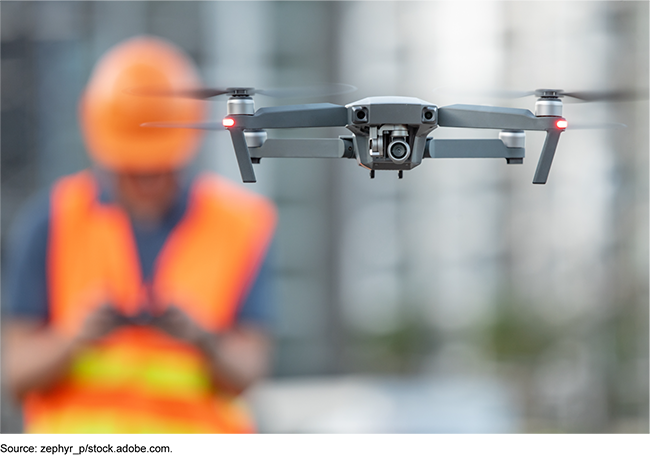Fast Facts
 The Federal Aviation Administration (FAA) is responsible for safely integrating drones into the national airspace—a complex network that includes airports, aircraft, and air traffic control facilities.
The Federal Aviation Administration (FAA) is responsible for safely integrating drones into the national airspace—a complex network that includes airports, aircraft, and air traffic control facilities.FAA has developed various planning documents to manage its efforts to integrate drones. But, it has yet to develop a comprehensive strategy to guide these efforts. For example, FAA's documents don't include important elements—such as goals, objectives, and milestones—that would help FAA manage more effectively.
We recommended that FAA develop a comprehensive strategy to integrate drones into the national airspace.
What GAO Found
The Federal Aviation Administration (FAA) is responsible for safely integrating drones into the national airspace system—a complex network that includes airports, aircraft, and air traffic control facilities. FAA has developed various planning documents to manage its drone integration efforts but has not developed a comprehensive strategy. GAO found that FAA's documents partially include four of the seven elements of a comprehensive strategy but do not include the remaining three elements. For example, FAA's documents describe activities that are completed, under way, and planned. However, the documents do not identify drone integration goals and objectives and partially include milestones and performance measures for all activities. FAA officials stated they are developing a drone integration strategy. However, the strategy's release has been delayed multiple times, and whether the strategy will provide a comprehensive approach is unclear. Establishing a strategy with all key elements is critical to FAA's ability to effectively manage its drone integration efforts.
FAA has not clearly communicated: how drone operators' requests to conduct advanced operations can meet specific requirements or what is FAA's process for reviewing and approving those requests. Currently, drone operators seeking to conduct advanced operations not allowed under existing rules must submit operational requests by applying for waivers or exemptions to conduct these operations (see example in fig.). However, more than half of 15 industry stakeholders told GAO that FAA has not clearly communicated the requirements it looks for when reviewing and approving advanced operations. As a result, they faced challenges working with multiple FAA offices on these requests. For example, stakeholders said they experienced lengthy reviews of their requests, and at times received conflicting information from different FAA offices. FAA officials said that they recognize that their process for reviewing operational requests is complex and that they plan to take steps to improve FAA's guidance. By more clearly communicating how to satisfy FAA's requirements and FAA's process for reviewing operational requests, applicants could be better positioned to provide FAA with the quality information needed to assess these requests.
Drone Operations Allowed under Part 107 Regulations and with a Waiver

aPilots may fly at night if they have completed an initial knowledge test or training under 14 C.F.R. § 107.65 after April 6, 2021. In addition, the drone must have lighted anti-collision lighting visible for at least 3 statute miles that has a flash rate sufficient to avoid a collision. 14 C.F.R. § 107.29.
Why GAO Did This Study
Drones can provide significant social and economic benefits. For example, drones can be used to inspect infrastructure, aid in disaster and wildfire response, and deliver medical supplies.
GAO was asked to review FAA's efforts to integrate drones into the national airspace system. This report examines, among other issues, the extent to which: (1) FAA's approach to managing its drone integration efforts is consistent with key elements for a comprehensive strategy and (2) FAA has clearly communicated its requirements and process for reviewing and approving operational requests.
GAO analyzed FAA's planning documents and reports. GAO interviewed FAA officials, eight participants in one of FAA's pilot programs, and 15 industry groups, representing manufacturers, operators, and others. GAO selected industry stakeholders due to their participation in FAA pilot programs and rulemaking advisory committees, among other factors.
Recommendations
GAO is making four recommendations, including that FAA: (1) develop a drone integration strategy that includes all elements of a comprehensive strategy and (2) evaluate its current documentation to identify options to more clearly communicate how applicants can satisfy drone operational request requirements and FAA's process for reviewing and approving operational requests. FAA concurred with GAO's recommendations.
Recommendations for Executive Action
Agency AffectedRecommendationStatusFederal Aviation Administration The Administrator of FAA should develop a drone integration strategy that includes all seven elements of a comprehensive strategy. (Recommendation 1)
When we confirm what actions the agency has taken in response to this recommendation, we will provide updated information.
Federal Aviation Administration The Administrator of FAA should evaluate its current documentation to identify options to more clearly communicate how applicants can satisfy drone operational request requirements, and communicate FAA's internal process for reviewing and approving operational requests. (Recommendation 2)
When we confirm what actions the agency has taken in response to this recommendation, we will provide updated information.
Federal Aviation Administration The Administrator of FAA should develop and document a formal lessons-learned process for its drone integration activities that includes all six key practices for a lessons-learned process. (Recommendation 3)
When we confirm what actions the agency has taken in response to this recommendation, we will provide updated information.
Federal Aviation Administration The Administrator of FAA should implement the formal lessonslearned process it develops for its ongoing drone integration activities, including Part 107 waiver reviews and the BEYOND program. (Recommendation 4)
When we confirm what actions the agency has taken in response to this recommendation, we will provide updated information.
Full Report
No comments:
Post a Comment